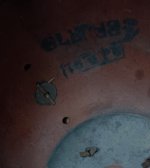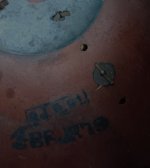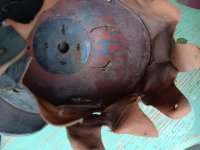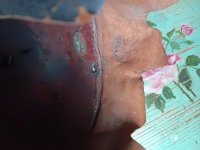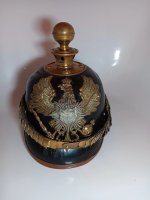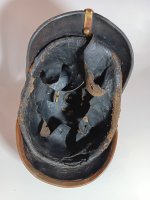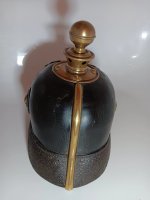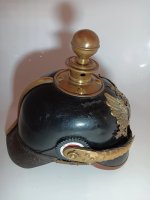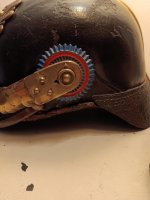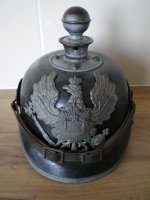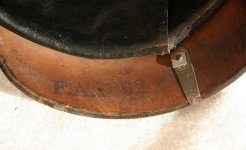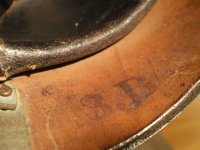You are using an out of date browser. It may not display this or other websites correctly.
You should upgrade or use an alternative browser.
You should upgrade or use an alternative browser.
A rare M95 felt lacquered Oldenburg
- Thread starter Adler
- Start date
stuka f
Well-known member
And I noticed a additional stamp on the back of th liner, but not able to read that one.
And a view of the front showing a big "H".
And a view of the front showing a big "H".
Attachments
argonne
Well-known member
Thank you a lot. The back of the liner ist not a stamp, it´s simply the print in the leather of the side post 91 fixation 
Yes, you clearly have here the 3B RJR79 . This helmet is simply wonderful!!!


Reserve-Infanterie-Regiment Nr. 79 (+MG.-Kp.)
Aufgestellt in Oldenburg (R.Stb., II., III.) und Aurich (I.)
Unterstellung: R.Stb., I. und II.: Besatzung Borkum.
III. und MG.-Kp.: 19. Res.Div.
Kommandeur: Oberstleutnant v. Gottberg (I.R.Nr. 91)
I.: Major Hennigs (I.R.Nr. 78)
Im Januar 1915 wurde das I. Bataillon umgebildet. Es bestand danach aus dem Stb.
sowie der 1., 4., 5. und 6. Kompanie.
Das Bataillon wurde zusammen mit dem I./L.I.R.Nr. 85 und dem II./L.I.R.Nr. 85 zu
einem neuen Reserve-Infanterie Regiment Nr. 79 zusammengestellt.
(Das I./L.I.R.Nr. 85 wurde II./R.I.R.Nr. 79, das II./L.I.R.Nr. 85 wurde III./R.I.R.Nr. 79.) (s.
S. 63). Nach Umbildung des I./R.I.R.Nr. 79 bildeten die 2., 3., 7. und 8. Kompanie das
neue II./R.I.R.Nr. 79.
II.: Major Ludowig (I.R.Nr. 91)
III.: Major Funk (I.R.Nr. 91)
Das III. Bataillon trat im August 1916 als III. Bataillon zum b. 29. I.R. (s. S. 244) und
wurde gem. K.M. v. 13.10.16 mit dem neuem II./R.I.R.Nr. 79 und dem IV./L.I.R.Nr. 75
(s. S. 60) zum R.I.R.Nr. 440 zusammengestellt.
This third bataillon fought separated from the rest of the RJR79 (I and II B), in the 39. Reserve Infanterie Brigade, together with the RJR74 and the RJR92.
1914 Westfront
Yes, you clearly have here the 3B RJR79 . This helmet is simply wonderful!!!
Reserve-Infanterie-Regiment Nr. 79 (+MG.-Kp.)
Aufgestellt in Oldenburg (R.Stb., II., III.) und Aurich (I.)
Unterstellung: R.Stb., I. und II.: Besatzung Borkum.
III. und MG.-Kp.: 19. Res.Div.
Kommandeur: Oberstleutnant v. Gottberg (I.R.Nr. 91)
I.: Major Hennigs (I.R.Nr. 78)
Im Januar 1915 wurde das I. Bataillon umgebildet. Es bestand danach aus dem Stb.
sowie der 1., 4., 5. und 6. Kompanie.
Das Bataillon wurde zusammen mit dem I./L.I.R.Nr. 85 und dem II./L.I.R.Nr. 85 zu
einem neuen Reserve-Infanterie Regiment Nr. 79 zusammengestellt.
(Das I./L.I.R.Nr. 85 wurde II./R.I.R.Nr. 79, das II./L.I.R.Nr. 85 wurde III./R.I.R.Nr. 79.) (s.
S. 63). Nach Umbildung des I./R.I.R.Nr. 79 bildeten die 2., 3., 7. und 8. Kompanie das
neue II./R.I.R.Nr. 79.
II.: Major Ludowig (I.R.Nr. 91)
III.: Major Funk (I.R.Nr. 91)
Das III. Bataillon trat im August 1916 als III. Bataillon zum b. 29. I.R. (s. S. 244) und
wurde gem. K.M. v. 13.10.16 mit dem neuem II./R.I.R.Nr. 79 und dem IV./L.I.R.Nr. 75
(s. S. 60) zum R.I.R.Nr. 440 zusammengestellt.
This third bataillon fought separated from the rest of the RJR79 (I and II B), in the 39. Reserve Infanterie Brigade, together with the RJR74 and the RJR92.
1914 Westfront
- 22.08.1914: Gefecht bei Monceau sur Sambre
- 23.08.1914 - 24.08.1914: Schlacht bei Namur
- 26.08.1914: Gefecht bei Marbaix, westlich Avesnes
- 27.08.1914: Gefecht bei Fesmy, südlich Landrecies
- 29.08.1914 - 30.08.1914: Schlacht bei St. Quentin
- 04.09.1914: Gefecht bei Le Breuil
- 06.09.1914 - 09.09.1914: Schlacht am Petit-Morin
- 12.09.1914 - 09.10.1914: Kämpfe bei Reims
- 17.09.1914: Erstürmung von Schloß Brimont
- 11.10.1914 - 04.02.1915: Kämpfe an der Aisne
- 06.02.1915 - 15.02.1915: Stellungskämpfe in der Champagne
- 16.02.1915 - 19.02.1915: Schlacht bei Perthes les Hurlus und Beausejour (4. Schlacht bei Perthes)
- 21.02.1915 - 20.03.1915: Winterschlacht in der Champagne
- 03.04.1915 - 16.04.1915: Stellungskämpfe in der Champagne
- 17.04.1915 - 17.05.1915: Reserve der Armee Abteilung Falkenhausen
- 17.05.1915 - 03.07.1915: Kämpfe bei Metzeral
- 17.05.1915 - 29.02.1916: Stellungskampf im Oberelsaß
- 14.06.1915 - 21.06.1915: Gefechte am Hilsenfirst
- 24.06.1915: Gefecht am Reichsacker-Kopf
- 20.07.1915 - 14.10.1915: Zweite Schlacht um Münster
- 21.12.1915 - 09.01.1916: Weihnachtskampf um den Hartmannsweilerkopf und Hirzstein
- 01.03.1916 - 14.03.1916: Stellungskampf im Oberelsaß
- 15.03.1916 - 12.07.1916: Schlacht um Verdun
- 17.04.1916: Erstürmung des Albain-Rückens
- 07.05.1916: Erstürmung der Thiaumont-Schlucht
- 23.05.1916: Sturm auf Thiaumont-Rücken, Thiaumont-Werk und Fleury
- 12.07.1916 - 07.10.1916: Kämpfe im Argonner Wald
- 08.10.1916 - 30.10.1916: Schalcht an der Somme
- 02.11.1916 - 16.02.1917: Stellungskämpfe zwischen Maas und Mosel, auf den Maashöhen bei Combres und an der Grande Tranchée de Calonne
stuka f
Well-known member
The date (stamp near the spike reinforcement plate)says "1914", so this could very well match.As I can see, the spike is screwable, so we can assume that this helmet is a late production because the OJR91 was very lately allowed to wear the black Haarbusch for parades, August 1913.
Philippe
stuka f
Well-known member
and something that allways puzzeld me, is the fact that the spilt pens aren't well fixed. The pen's are not properly bent to the 90 degrees they should be...The date (stamp near the spike reinforcement plate)says "1914", so this could very well match.
argonne
Well-known member
Probably a vet bring back. It was pretty common that the spikes were first disassembled to transport them in a bred bag, for example,, and then later at home assembled again in this way. It is very difficult to fix those splits exactly strong as they were initially, but not impossibleand something that allways puzzeld me, is the fact that the spilt pens aren't well fixed. The pen's are not properly bent to the 90 degrees they should be...
Philippe
argonne
Well-known member
You can´t have it better!The date (stamp near the spike reinforcement plate)says "1914", so this could very well match.
Philippe
John Josef
Well-known member
Beautiful FAR 62 by the way.
I own a rare M15 marked to the third battery, as only this battery and the second were Oldenburg, all others were prussian.
View attachment 41023
View attachment 41024
View attachment 41025
Philippe
I'm in love, that is a thing of beauty
Thanks for sharing
Oldenburg
Well-known member
Philippe,Beautiful FAR 62 by the way.
I own a rare M15 marked to the third battery, as only this battery and the second were Oldenburg, all others were prussian.
View attachment 41023
View attachment 41024
View attachment 41025
Philippe
and again the cautious question:
If this helmet were to leave you, I would be prepared to do a great deal...
Frank
argonne
Well-known member
Hi Frank,If this helmet were to leave you, I would be prepared to do a great deal...




I just picked up this helmet last summer in Paris, driving 2000 km, to avoid any risk of loss or damage with shipping...
I think it will first stay a while at its new home
However, I've noted your interest
Philippe
stuka f
Well-known member
I can understand that!Hi Frank,
I just picked up this helmet last summer in Paris, driving 2000 km, to avoid any risk of loss or damage with shipping...
....
That is what I do now as well.
Lost all trust in postal services...

